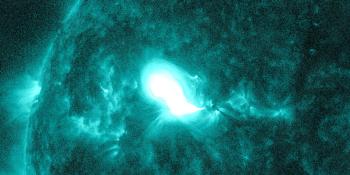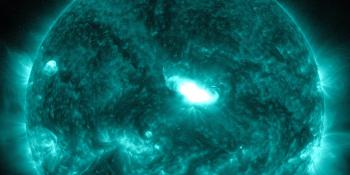Przeglądasz Archiwum z poniedziałek, 23 stycznia 2012
Raport aktywności słonecznej
Każdy wspomniany rozbłysk słoneczny w tym raporcie ma współczynnik skalowania dodany przez Space Weather Prediction Center (SWPC). Przez skale współczynników SWPC, raporty o rozbłyskach słonecznych są o 42% mniejsze niż naukowo jakościowa data. Skale współczynników zostały usunięte z naszych archiwów o rozbłyskach słonecznych by odzwierciedlić prawdziwe jednostki fizyczne.
Raport aktywności słoneczno- geomagnetycznej 2012 Jan 23 2200 UTCPrzygotowane przez NOAA © SWPC i przetworzone przez SpaceWeatherLive.com
Połączenie raportów USAF/NOAA o słonecznej i geofizycznej aktywności
Numer SDF 023 wydany w 2200Z na 23 Jan 2012IA. Analiza aktywności regionów słonecznych i aktywność od 22-2100Z do 23-2100Z Solar activity reached high levels. Region 1402
(N28W36) produced a long-duration M8/2b flare at 23/0359Z.
Associated with this event were multi-frequency radio emissions
spanning 25 MHz through 15.4 GHz including a 5100 sfu Tenflare.
SOHO/LASCO observed an asymmetric, full-halo CME, first observed in
C2 imagery at 27/0412Z as a bright halo over the northern
hemisphere. Model output suggests potential Earth impact midday on
24 January. Region 1402 showed some umbral separation in the large
leader spot. Region 1401 (N16W39) produced a C1/Sf at 23/2011Z.
The remainder of the disk was quiet and stable.
IB. Prognoza aktywności słonecznej
Solar activity is expected to be low
during the period (24 - 26 January) with M-class activity likely
from Regions 1401 and 1402.
IIA. Podsumowanie aktywności geofizycznej 22-2100Z do 23-2100Z
The geomagnetic field ranged from quiet to minor storms levels. The
period began with active to minor storm conditions as the field was
under the influence of the 19 January CME. By 23/0600Z, the field
became mostly quiet to unsettled. Solar wind speeds began the
period at about 450 km/s while the Bz component of the
interplanetary magnetic field (IMF) was at about -10 nT. By about
0630Z, wind speeds dropped sharply to near 300 km/s, density dropped
to near 0 p/cc and IMF Bz turned northward. These signatures were
consistent with a possible reverse shock at the back end of the CME.
The greater than 10 MeV proton flux at greater than or equal to 10
pfu and the greater than 100 MeV proton flux at greater than or
equal to 1 pfu at geosynchronous orbit were above threshold during
the period. The 10 MeV event began at 23/0530Z and reached at
maximum of 3100 pfu at 23/1940Z. The 100 MeV event began at
23/0445Z and reached a maximum of 2.3 pfu at 23/0750Z. Both events
were still in progress at the time of this report.
IIB. Prognoza aktywności geofizycznej
The geomagnetic field is
expected to range from quiet to isolated severe storm levels on day
one (24 January). Mostly quiet levels are expected through midday
on 24 January when the anticipated arrival of the 23 January CME is
expected to affect the field. Active to major storm levels, with
isolated severe storm periods, are expected for the remainder of day
one. By day two (25 January), field activity is expected to
decrease to unsettled to active levels, with isolated minor storm
periods, as effects from the CME wane. Day three (26 January)
should see a return to mostly quiet conditions.
III. Prawdopodobieństwa zdarzenia 24 Jan do 26 Jan
| Klasa M | 60% | 60% | 60% |
| Klasa X | 10% | 10% | 10% |
| Proton | 99% | 99% | 50% |
| PCAF | Green | ||
IV. Przepływ 10,7 cm z Penticton
Zaobserwowano 23 Jan 144 Przewidywane 24 Jan-26 Jan 145/145/145 Średnia z 90 dni 23 Jan 143
V. Indeks geomagnetyczny A
Zaobserwowano Afr/Ap 22 Jan 022/024 Szacowane Afr/Ap 23 Jan 008/009 Przewidywane Afr/Ap 24 Jan-26 Jan 022/042-018/020-005/005
VI. Prawdopodobieństwa aktywności geomagnetycznej 24 Jan do 26 Jan
| A. Średnie szerokości geograficzne | |||
|---|---|---|---|
| Aktywne | 15% | 30% | 05% |
| Słaba burza | 35% | 15% | 01% |
| Bardzo znacząca burza | 20% | 01% | 01% |
| B. Wysokie szerokości geograficzne | |||
|---|---|---|---|
| Aktywne | 20% | 40% | 10% |
| Słaba burza | 50% | 25% | 05% |
| Bardzo znacząca burza | 30% | 10% | 01% |
Wszystkie czasy w UTC
<< Idź do codziennego przeglądu
Najnowsze wiadomości
Najnowsze wiadomości z forum
Unspecified geomagnetic activity 1637AR13883 2024/11/04 CME 45sun goes blank 72Space Weather Memes 566Incoming & Unnumbered Active Regions 1209
Więcej tematówWesprzyj SpaceWeatherLive.com!
Wielu ludzi odwiedza SpaceWeatherLive aby śledzić aktywność słoneczną lub sprawdzić czy jest szansa na zaobserwowanie zorzy polarnej. Niestety, większy ruch na stronie oznacza większe koszty utrzymania serwera. Dlatego, jeśli jesteś zadowolony ze strony SpaceWeatherLive, zachęcamy do wspierania nas finansowo. Dzięki temu będziemy mogli utrzymać naszą stronę.

Fakty na temat pogody kosmicznej
| Ostatnie rozbłyski klasy X | 2024/11/06 | X2.39 |
| Ostatnie rozbłyski klasy M | 2024/11/13 | M1.7 |
| Ostatnia burza geomagnetyczna | 2024/11/10 | Kp5+ (G1) |
| Dni bez plam słonecznych | |
|---|---|
| Ostatni dzień bez skazy | 2022/06/08 |
| Średnia miesięczna liczba plam słonecznych | |
|---|---|
| października 2024 | 166.4 +25 |
| listopada 2024 | 166 -0.4 |
| Ostatnie 30 dni | 163.2 +18.4 |


